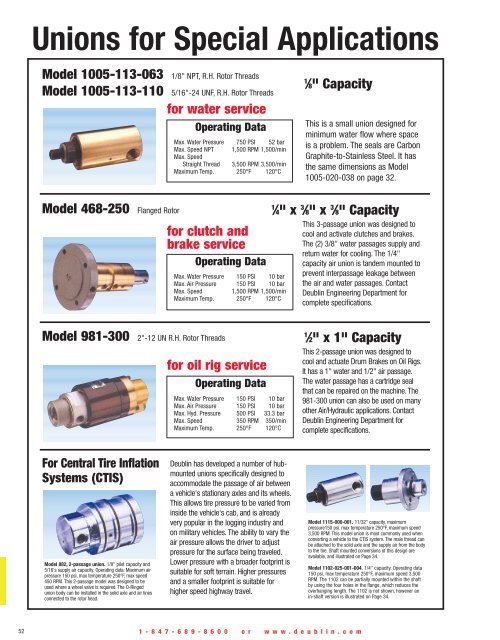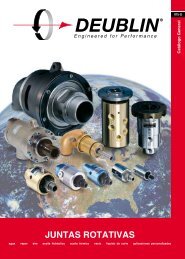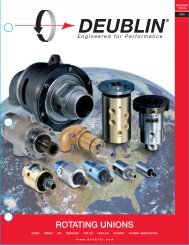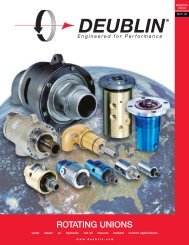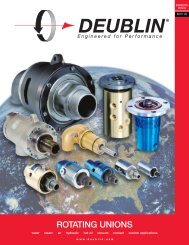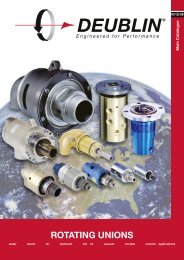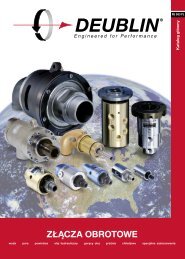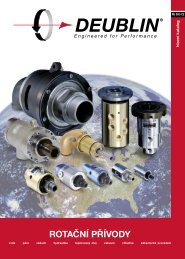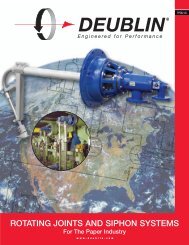You also want an ePaper? Increase the reach of your titles
YUMPU automatically turns print PDFs into web optimized ePapers that Google loves.
52<br />
<strong>Unions</strong> for Special Applications<br />
Model 1005-113-063 1/8" NPT, R.H. Rotor Threads<br />
Model 1005-113-110 5/16"-24 UNF, R.H. Rotor Threads<br />
for water service<br />
Model 468-250 Flanged Rotor<br />
Operating Data<br />
Max. Water Pressure 750 PSI 52 bar<br />
Max. Speed NPT 1,500 RPM 1,500/min<br />
Max. Speed<br />
Straight Thread 3,500 RPM 3,500/min<br />
Maximum Temp. 250°F 120°C<br />
for clutch and<br />
brake service<br />
Operating Data<br />
Model 981-300 2"-12 UN R.H. Rotor Threads<br />
For Central Tire Inflation<br />
Systems (CTIS)<br />
Model 882, 2-passage union. 1/8" pilot capacity and<br />
5/16's supply air capacity. Operating data: Maximum air<br />
pressure 150 psi, max temperature 250°F, max speed<br />
450 RPM. This 2-passage model was designed to be<br />
used where a wheel valve is required. The O-Ringed<br />
union body can be installed in the solid axle and air lines<br />
connected to the rotor head.<br />
Max. Water Pressure 150 PSI 10 bar<br />
Max. Air Pressure 150 PSI 10 bar<br />
Max. Speed 1,500 RPM 1,500/min<br />
Maximum Temp. 250°F 120°C<br />
for oil rig service<br />
Operating Data<br />
Max. Water Pressure 150 PSI 10 bar<br />
Max. Air Pressure 150 PSI 10 bar<br />
Max. Hyd. Pressure 500 PSI 33.3 bar<br />
Max. Speed 350 RPM 350/min<br />
Maximum Temp. 250°F 120°C<br />
Deublin has developed a number of hubmounted<br />
unions specifically designed to<br />
accommodate the passage of air between<br />
a vehicle's stationary axles and its wheels.<br />
This allows tire pressure to be varied from<br />
inside the vehicle's cab, and is already<br />
very popular in the logging industry and<br />
on military vehicles. The ability to vary the<br />
air pressure allows the driver to adjust<br />
pressure for the surface being traveled.<br />
Lower pressure with a broader footprint is<br />
suitable for soft terrain. Higher pressures<br />
and a smaller footprint is suitable for<br />
higher speed highway travel.<br />
1 ⁄8" Capacity<br />
This is a small union designed for<br />
minimum water flow where space<br />
is a problem. The seals are Carbon<br />
Graphite-to-Stainless Steel. It has<br />
the same dimensions as Model<br />
1005-020-038 on page 32.<br />
1 ⁄4" x 3 ⁄8" x 3 ⁄8" Capacity<br />
This 3-passage union was designed to<br />
cool and activate clutches and brakes.<br />
The (2) 3/8" water passages supply and<br />
return water for cooling. The 1/4"<br />
capacity air union is tandem mounted to<br />
prevent interpassage leakage between<br />
the air and water passages. Contact<br />
Deublin Engineering Department for<br />
complete specifications.<br />
1 ⁄2" x 1" Capacity<br />
This 2-passage union was designed to<br />
cool and actuate Drum Brakes on Oil Rigs.<br />
It has a 1" water and 1/2" air passage.<br />
The water passage has a cartridge seal<br />
that can be repaired on the machine. The<br />
981-300 union can also be used on many<br />
other Air/Hydraulic applications. Contact<br />
Deublin Engineering Department for<br />
complete specifications.<br />
1 - 8 4 7 - 6 8 9 - 8 6 0 0 o r w w w . d e u b l i n . c o m<br />
Model 1115-000-001. 11/32" capacity, maximum<br />
pressure150 psi. max temperature 250°F, maximum speed<br />
3,500 RPM. This model union is most commonly used when<br />
converting a vehicle to the CTIS system. The male thread can<br />
be attached to the solid axle and the supply air from the body<br />
to the tire. Shaft mounted conversions of this design are<br />
available, and illustrated on Page 34.<br />
Model 1102-025-001-004. 1/4" capacity. Operating data<br />
150 psi, max temperature 250°F, maximum speed 3,500<br />
RPM. The 1102 can be partially mounted within the shaft<br />
by using the four holes in the flange, which reduces the<br />
overhanging length. The 1102 is not shown, however an<br />
in-shaft version is illustrated on Page 34.


